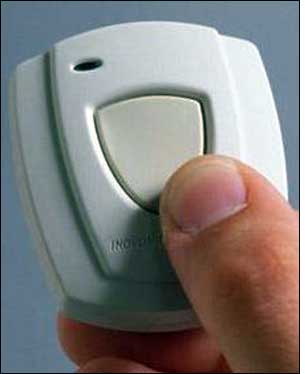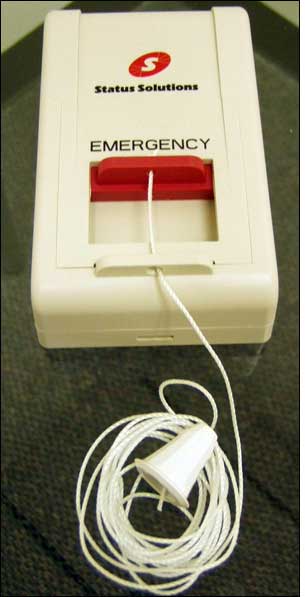At Dogwood Village, a skilled nursing and assisted-living facility in Orange, Va., residents utilize RFID-enabled pendants and pull-cords to summon aid. The solution, provided by Status Solutions, is known as the Situational Awareness and Response Assistant (SARA). This system enables employees to know when a patient has pressed a pendant’s alert button, as well as how long it takes for the staff to respond. Dogwood Village is now expanding its SARA deployment, and intends in the future to add temperature-sensing capabilities for such equipment as refrigerators and boilers, as well as locators to determine where in the assisted-living building a resident is when pressing a button.
Previously, Dogwood’s skilled nursing rooms, which can accommodate a total of 138 residents, had two-way intercoms to allow residents to request help from the staff. When a patient pulled a cord attached to a switch mounted near her bed, it activated an intercom, enabling her to speak with a nurse working at a central station. That system, however, was not meeting the needs of the patients or employees, says Vernon Baker, Dogwood Village’s president. A call could only be heard at the nursing station itself, making it more difficult for the appropriate staff members to respond if they were not at the station. What’s more, the two-way calling confused many residents who could press the button for help, but had trouble understanding what nurses were saying over the intercom, or how they should respond. Workers also sometimes had trouble understanding the patients.
Dogwood Village implemented the pull-cord version of the SARA system at its 138-patient nursing home in 2006, and is now installing the pendant version at a new 75-resident assisted-living facility. The RFID-enabled pull-cord devices and pendants, as well as the solution’s other RFID hardware, are manufactured by Inovonics.
Each pull-cord or pendant contains an active RFID tag that transmits a 902-928 MHz signal encoded with a unique ID number linked to the resident’s name, history, room number and other information stored in the facility’s back-end system. The pull-cord device, wired to a power supply, can be attached to a wall or bed. The pendant, which contains an internal battery, attaches to a lanyard worn around a patient’s neck, and the patient presses a button on the pendant to summon help.
Each type of device beacons its unique ID number intermittently at all times, in order to confirm it is operating properly. According to Deric Blattenberger, Status Solutions’ product manager, an Inovonics repeater (17 such devices are installed at the facility altogether) receives the ID number and sends it to a second repeater, which forwards the data to a centrally located receiver.
If the device’s status changes—in other words, if a patient pulls its cord—it sends a modified transmission indicating a patient seeks assistance. The receiver has a cabled connection to the back-end system, where Status Solutions’ SARA software receives the data, uses the ID number to determine the name and room of the patient who placed the call, and sends a text alert to the appropriate staff members’ pagers or phones.
When a worker receives a text alert on her pager or phone, she sees a display of the patient’s name and room number, then reports to that room. There, she resets the switch on the patient’s pull-cord device or presses a recessed reset button on the back of the pendant, thus indicating the call has been answered.
If employees do not respond to the call within five minutes, a second page is sent, this time including the charge nurse, and then once more, including the unit manager. If no one responds within 20 minutes, Baker says, he receives a phone call himself.
The assisted-living facility now has 38 residents, though that number is expected to grow to approximately 75. Residents utilize a pendant instead of the pull-cord device used by nursing patients, because assisted-living residents are more mobile.
In both cases, the SARA system not only ensures that every call receives a response, it also records how long that response took. Once the pendant or pull-cord device is reset, the system records the response time, as well as who responded. Management can then use those records to determine how well the staff responds to calls, and track a specific problem if one is reported after the fact.
One example of the system in action illustrates the numerous ways in which it can be used, Baker says. Several weeks ago, he spoke with a resident who indicated the staff had taken too long responding to her calls the previous night. Baker was able to check the SARA records, determine when the calls were placed and which staff member was on call, and speak with that employee. However, he adds, he was also able to surmise that the resident was experiencing high levels of anxiety at the time, pressing the call button approximately 30 times a day for a variety of needs. With that knowledge, he says, the staff was then better able to understand the patient’s problems and address them.
In another case, Baker says, family members of a resident indicated she reported not getting responses to her calls. However, the system determined the number of calls she had placed during the night, along with the average response time (for example, 10 calls with an average response of 2 minutes 32 seconds).
In the future, Baker says, the facility intends to install SARA locators, which identify each pendant’s location when the call button is pressed. In that way, if a resident requires assistance but is not in his room, the system can identify in which floor and wing he is located. That, he says, will require installing 12 locators at the assisted-living, facility—one each in the north, south, east and west wings of every floor.
Baker says he was initially concerned that employees would resist switching to the SARA system. However, he says, they appreciate seeing just how long their own response times are, and different departments have competed to achieve the quickest response times.



